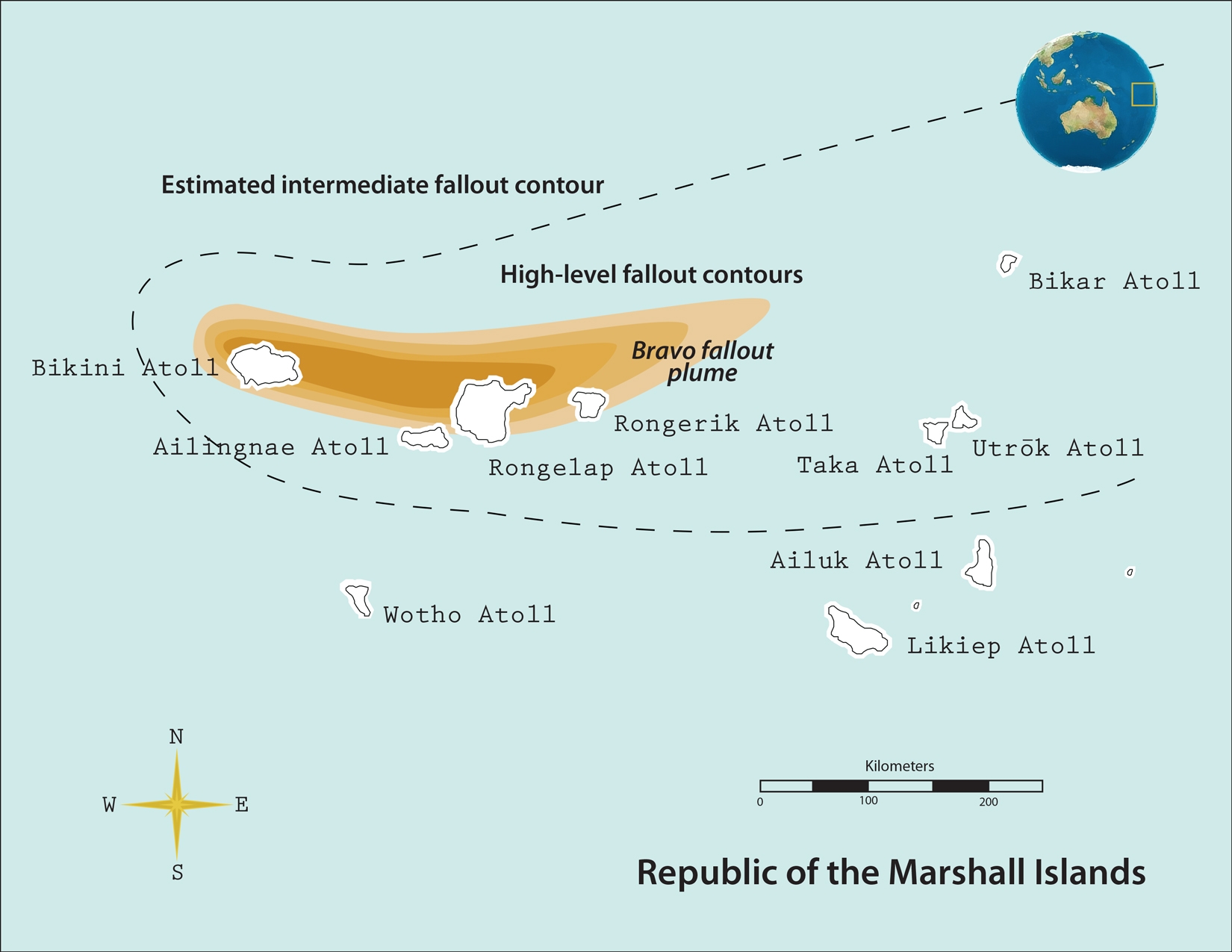The Marshall Islands

The Marshall Islands consists of 29 coral atolls and five low-lying islands. Located halfway between Hawaii and Australia, the Marshall Islands were the site of 67 U.S. nuclear weapons tests from 1946 to 1958.
The Marshall Islands Dose Assessment and Radioecology Program conducted by the Lawrence Livermore National Laboratory (LLNL) under the auspices of the U.S. Department of Energy (DOE) is a broad-based, interdisciplinary research and monitoring program in marine and terrestrial radioecology. The program forms part of the U.S.-mandated response under the U.S. Department of Energy (DOE) Office of Health and Safety (EHSS) to the legacy of nuclear testing in the Marshall Islands as memorialized in U.S. statues (Public Laws 95-134, section 104; 96-205, section 106, 99-239, section 103; and 112-149, section 2).
We perform environmental monitoring and assess exposures of resettled and resettling populations to residual fallout contamination in the environment. Studies have shown that the largest contributor to the manmade radiation dose in the Marshall Islands is from internal and external exposure to cesium-137 (137Cs). Internally deposited cesium-137 is taken up in peoples’ bodies from eating locally grown foods. We have established three whole-body counting facilities in the Marshall Islands with the aim of assessing people’s exposure to dietary cesium-137.
Another key area of study is to provide an assessment of any long-term risks posed by radioactive constituents contained in the Cactus Crater Containment Structure on Runit Island at Enewetak Atoll. The study was developed in support of the Insular Areas Act of 2011, Public Law P.L. 112–149.
Pūrokraam in Ekkatak kin joñan Dose im Radiation ilo Majōl in im Lawrence Livermore National Laboratory (LLNL) ej eddoiki iumin tel eo an U.S. Department of Energy (DOE) im ej ra eo, ekūtbuuj ekkatak ko im etale ko kin makūtkūt in radiation ion āne im lojet. Pūrokraam in ear ejaak mōttan wōt kon ak eddo eo an U.S ñan uaake ta ko raar walok jen wot iien kōmālmel in nuclear ko maantak ilo Majōl.
Jej kōmmane etale ko im joñak ko ikijeen jedmatmat in radiation ñan jukjukin pād ko im armej ro ilo aer rool im jokwe ilo kabijuknen. Ekkatak kein rar kwalok ke joñan radiation kōmman in armej im elap kunaan ilo Majōl in ilo an jelet tulowa im tulik ñan armij, ej jen cesium-137 (137Cs). Cesium-137 eo ear pād tulowan armej ear deloñe enbwin ilo ad kañi mōñā ko kijed make im rej eddōk ilo Majōl in. Ededelok ad kōmmane jilu Error! Hyperlink reference not valid. ak mōn būne joñan radiation ilo enbwin ilo Majōl in, im kōtōbar eo ej ñan etale jonan cesium-137 iben armij jen mōñā ko kijed. Mōn bōnbōn kein repād ilo aelōñ in Enewetak, Majuro, im Rongelap.
Bar juon wawen eo eaorok non katak ej ñan kōmmane juon elmakot eo non lale ta ko remaron kauwatata jen driwōjlok in kopej in radiation ko ilo jikin kakwōn eo ilo Runit Enewetak ilo ad remanlok non iioo ko tokelik. Katak in ear ejaak jen jipañ eo ekkar ñan Insular Area Act 2011 eo, Public Law P.L. 112-149.
A BRIEF HISTORY OF US NUCLEAR TESTING IN THE MARSHALL ISLANDS
Immediately after World War II, the United States created a joint task force to develop a nuclear weapons testing program. Planners decided that coral atolls in the northern Marshall Islands were an ideal site for these tests because of their stable weather conditions, low number of inhabitants to relocate, and remote isolation.
The largest of these tests was Castle Bravo, which was conducted on Bikini Island on March 1, 1954. Bravo was an experimental thermonuclear device with an estimated explosive yield of 15 megatons. Its detonation unexpectedly caused widespread regional fallout contamination and forced the evacuation of local population groups living on Rongelap and Utrōk Atolls to the east of Bikini.

Prior to the Castle Bravo test, little consideration was given to the potential impact of fallout occurring beyond the immediate vicinity of test sites. Bravo caused significant contamination over inhabited islands of Rongelap and Utrōk Atoll and other atolls to the east of Bikini.
ACKNOWLEDGMENTS
We wish to thank our sponsors at the U.S. Department of Energy, and to show our appreciation for the cooperative efforts of local atoll leaders and their representatives in supporting the development, implementation, and ongoing execution of this program. We also wish to thank our Marshallese technicians for their valuable contribution to the Marshall Islands Individual Radiological Protection Monitoring Program.




